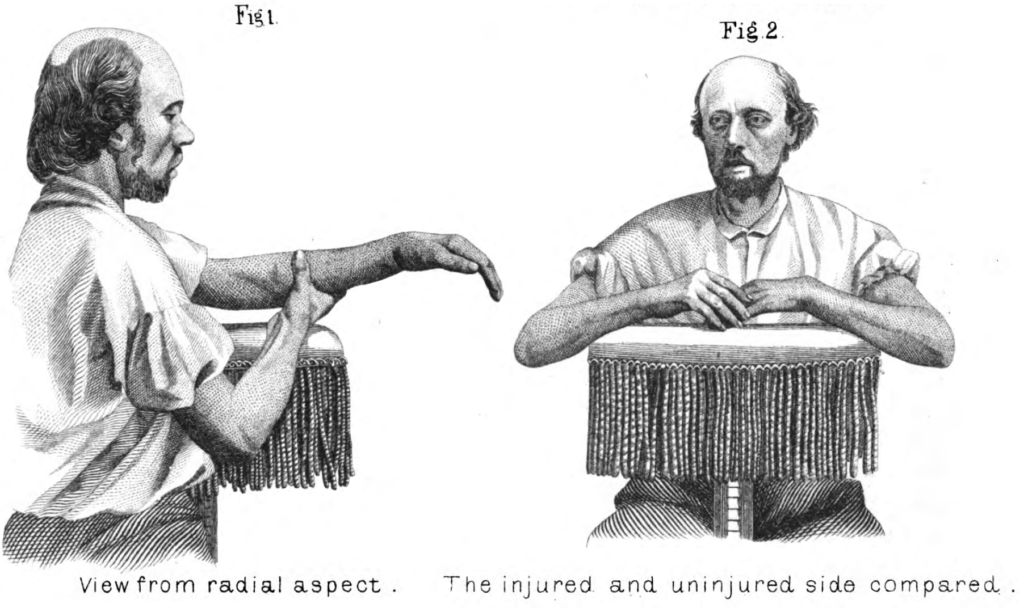Moore fracture
Description
Moore’s fracture is a fracture of the distal radius of the Colles variety.
Fracture of the lower end of the radius with fracture of the ulna styloid; subluxation of the ulna head; and entrapment of the ulna styloid process under the annular ligaments.
History of the Moore fracture
In 1814, Abraham Colles provided a description of the symptoms of a fracture of the carpal extremity of the radius in the time before X-ray.
Colles did not describe a fracture of the ulna styloid (although currently fractures of the distal radius, with or without ulna styloid fracture bear his name)
In 1869, Edward Moore described ulna luxation with and without fracture of the ulna styloid in clinical cases, post mortem dissections and cadaveric experiments.
He examined the fractured wrists of a 45 year old patient who in a ‘paroxysm of insanity’ jumped three stories to her death, from St. Mary’s Hospital
The projection of the wrist backward was that of an extreme case of [Colles] fracture, and the ulna was carried well downward and outward from the axis of the fore-arm. The fracture was transverse and the surface of the lower fragment, which was about half an inch in length, came in contact with the periosteal surface of the back of the upper fragment or main shaft.
The next step in the manipulation was to press the displaced fragment into its place. I was surprised to find a resistance which seemed like muscular action. This being manifestly impossible, the cause was again sought for by a repetition of the movement, when the same result was produced giving an elastic rebound.
The solution was found in the peculiar position of the ulna, its luxation and ligamentous entanglement.
The cause of rebound now became manifest; for the styloid process was so far projected as to catch the fibres of the annular ligament, and the ulna being prevented from rising, forced the wrist back.
Moore, 1870

Moore then conducted cadaver experiments in order to evaluate the variation from the Colles-type distal radius fractures:
I subjected the arm of a cadaver to a force gradually applied, after having made a fracture of the radius just above the wrist-joint. This was effected by strapping the arm firmly down and attaching a lever to the hand, then bending the latter well back with a slow but irresistible force.
When the internal lateral ligament and triangular fibro-cartilage yield, the annular ligament becomes slipped over the head and on the styloid hook. In order to determine the succession of movement in the ligamentous rupture, I subjected the arm of a cadaver to a force gradually applied, after having made a fracture of the radius just above the wrist-joint.
The bulging of the ulna outward and downward preceded the rupture of the internal lateral ligament. But the fascia of the fore-arm lying on the ulnar head became stretched, and fibres of the annular ligament slipped over it. As the force was continued, a double snap, loud and sharp, was produced by the breaking of the internal lateral ligament and the triangular fibro-cartilage, apparently in the order stated. The end and internal surface of the styloid was broken off. The annular ligament at the same moment was caught on the styloid, presenting precisely the appearance shown by the autopsy.
If there should be an arrest of movement before ligamentous rupture, the difficulty is one of simple Colles fracture uncomplicated with luxation of the ulna.
Moore, 1870
Moore, of Rochester, says that in addition to transverse fracture, there is a rupture of the triangular fibro-cartilage and internal lateral ligament, and a dislocation of the ulna.
Moore, after stating “that all difficulty in treatment disappears when the luxation is restored,” gives the following method for reduction: 1, extend; 2, incline hand to radial side; 3, push the head backward; 4, keeping backward, while extending swing, well to ulna side, and flex the hand.
Hamilton 1877
Associated Persons
- Abraham Colles (1773-1843) [Colles fracture]
- Edward Mott Moore (1814-1902)
References
Historical references
- Moore EM. A luxation of the ulna not hitherto described, with a plan of reduction and mode of after treatment; including the management of Colles’ fracture. Transactions of the Medical Society of the State of New York. 1870; XV: 233-245
Eponymous term review
- Oaks JF. Observations on the treatment of Colles’ fracture. Medical union. 1873: 246-248
- Hamilton FH. Remarks on Colles’ fracture. Ohio medical and surgical journal. 1877; II: 5-9
- Rutkow IM. Edward Mott Moore In: History of Surgery in the United States, 1775-1900, 1992; II: 163
[cite]
eponymictionary
the names behind the name


